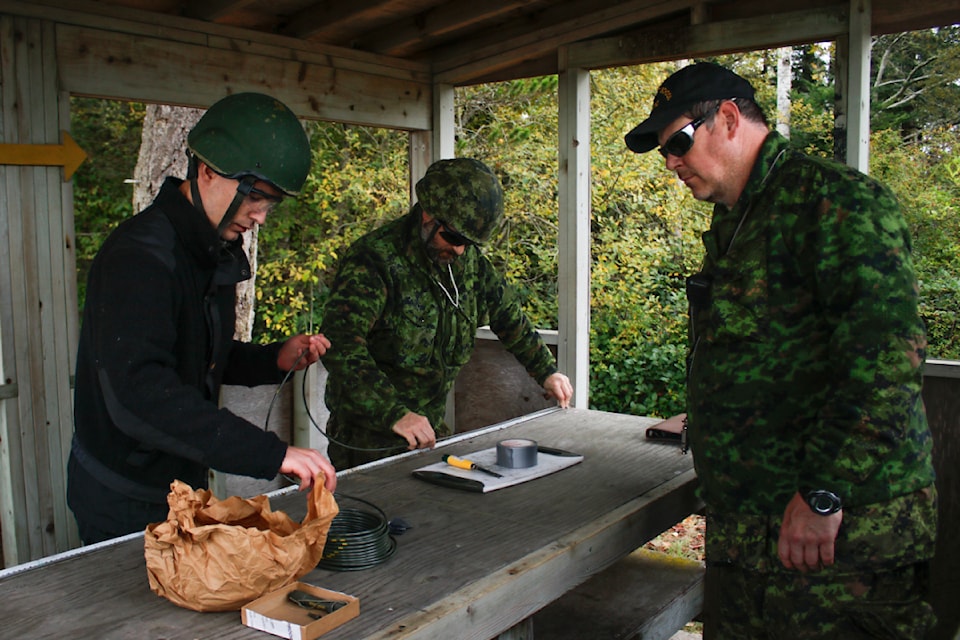As dawn broke over CFB Esquimalt on Oct. 2, members of the Canadian Armed Forces, including about a dozen new boatswains, mounted rigid hull inflatable boats and set off for Bentinck Island, a secluded patch of land off the coast of Metchosin.
As the boats carved through the rough waters of the Eastern Pacific, the new sailors, who had just finished their basic training months before, mentally prepared for a cardinal moment of their naval careers – learning to set up and detonate C-4 charges. They would soon be handling an explosive the military uses to fell trees, sabotage infrastructure, and destroy enemy caches.
As the group crowded under an army-green tent in the staging area, Petty Officer 1st Class (PO1) Boyko, officer in charge, and PO1 Holden, range safety officer, briefed the group on the rules and procedures of the range, which includes a ban on cell phones due to a possible – but unlikely – premature trigger of the explosives.
Following the brief, the group made its way to the range, hiking through the thick forest on an overgrown path made for ATVs, walking past the ruins of houses and hospitals made for the former island residents. In 1924, leprosy patients were moved to Bentinck Island from D'arcy Island near Cordova Bay, where they lived until the last patient died in 1957. Since then, only the CAF, local First Nations, and scientists have been able to use the island.
When the troupe of sailors and soldiers arrived at the range, a rocky clearing on the coast with a concrete bunker to protect personnel from shrapnel, members start setting up their "projects" – pieces of driftwood mimicking a tree, and a small driftwood structure about 20 metres away from the first.
PO1 Charles Chapman, who has worked with explosives on the island for years, explained they use driftwood to leave the smallest possible footprint, and when they do detonations on steel, they take steel scraps off the island in the following weeks.
"We don't try to bring extra stuff out here because we don't want to do anything to the environment, or make changes to anything. Nothing stays on the island because we try to maintain zero impact," he said. "The only impact we do have is [we make] little craters [from the explosions], but the guys come in with shovels and fill those craters [after we're done]."
When the projects are in place, members start laying out detonation cords, a high-speed fuse that explodes – rather than burns – at a rate of about 8,000 metres per second. The cords are laid out in intricate patterns, with more than one fuse on each explosive, which prevents a misfire if one cord or fuse is faulty.
While some trainees place the cord, others attach the C-4 charges to the driftwood.
Chapman explained that C-4 is a relatively stable explosive and can't be set off by dropping it or shooting it, like TNT, until it is properly detonated by a shock wave when an igniter is fired. On this day, the trainees used about four to five kilograms of C-4 per project.
After the explosives and the detention cord is in place, the group gathers at the bunker for safety. The commanding officer and one of the trainees attach the fuse cord, which will detonate the charges, in between the C-4 and the detonation cord.
The fuse cord burns much slower than the detonation cord, at around a second per centimetre, so they calculate how much cord to use to time the detonations and the delay between each detonation.
"It's not actually how you've seen it in the movies with the bright spark; it just smokes and as it goes you'll see it burn," said Chapman.
They also test one metre of the fuse cord in the morning and time how long it takes to burn, to confirm it works ahead of the detonation.
"We have to do the burn because the moisture in the morning ingresses into the end, and if there's even a little bit of moisture in there, it might not go off, or it will slow the burn rate down," he explained.
While crammed in the small bunker, peering through small, cloudy windows made of re-enforced glass, the trainees watched in awe as the two projects detonated.
In tandem with the explosions, two pairs of sentries on boats turned around civilian boaters that got too close to the island, and another boat with third-party scientists used underwater microphones to make sure no whales or other marine mammals were nearby.
There is also a medical technician on hand and a helicopter pad for timely medical evacuation in case of an accident. In case the project does not detonate, which rarely happens, the team waits 30 minutes before coming out of the bunker to check it out.
On top of boatswains using the island for demolitions, other groups such as the Fleet Diving Unit also do demolitions on the island, usually using bigger, more unstable explosives.
Though there is no future date for more training yet, as dates fluctuate due to factors such as weather and wildfire risk, the Royal Canadian Navy releases public service announcements a week in advance for Metchosin and adjacent residents, who may have concerns with the blasting.


